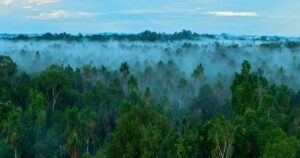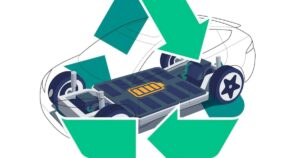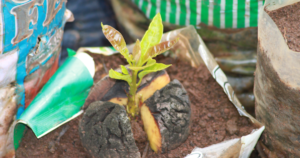
The elephants are gone. The trees are logged out. The Beng Per Wildlife Sanctuary in central Cambodia is largely destroyed, after being handed over by the government to a politically well-connected local plantation company to grow rubber.
In West Africa, the Luxembourg-based plantations giant Socfin has been accused in recent weeks of deforestation and displacing Indigenous people around its rubber plantations in Nigeria and Ghana.
Meanwhile, on the heavily deforested Indonesian island of Sumatra, tire multinational Michelin and a local forestry company raised $95 million worth of green investment bonds on the promise that they would reforest bare land with rubber trees. But the NGO Mighty Earth has found that much of the plantation went ahead on land from which natural forest had been removed as recently as a few months before by a subsidiary of the local company.
These are just three examples among hundreds of one of the biggest, but least discussed, causes of tropical deforestation. The spread of rubber plantations is driven primarily by our demand for more than 2 billion new tires each year. The full devastating impact of this has been exposed by a new analysis of high-resolution satellite images that can, for the first time, distinguish rubber plantations from natural forests.
Rubber as a crop is a worse deforester than coffee or cocoa and is closing in on palm oil for the top spot.
But even as the true environmental cost of the ubiquitous rubber tire is being exposed, the damage could be about to escalate sharply. The new culprit is electric vehicles. Being substantially heavier than conventional vehicles, they reduce the life of a tire by up to 30 percent, and so could raise demand for rubber by the same amount.
Natural rubber is a milky latex harvested manually by tapping the bark of the Hevea brasiliensis, a tree originally from the Amazon now grown widely in plantations, especially in Southeast Asia. World demand has been rising by more than 3 percent a year. But with no sign of increased yields on plantations, which requires ever more land to keep pace.
Yet there has been little outrage. While growers and processors of other tropical commodity crops, such as soy, beef, palm oil, cocoa and coffee, are under ever greater pressure from both regulators and consumers to show their products are not grown on land deforested to accommodate them, rubber has escaped public attention. When did you last see deforestation-free rubber tires advertised?
One reason for this environmental blind spot is that the truth has not been able to be seen by the remote-sensing systems used to track changing land use in much of the tropics. Unlike with other commodity crops, even the most assiduous analysis of satellite images of forest regions has been unable to distinguish the foliage of monocultures of rubber trees from the canopies of natural forests.
Until now.
A new international analysis published in October has for the first time used high-resolution imagery from the Sentinel-2 earth observation satellites, launched by the European Space Agency, to accurately identify rubber plantations. "The results have been sobering," says lead author Yunxia Wang, a remote-sensing specialist at the Royal Botanic Garden Edinburgh.
She has found that between 10 million and 15 million acres of tropical forests, an area larger than Switzerland, has been razed in Southeast Asia alone since the 1990s to feed our hunger for rubber. This is three times more than some previous estimates used by policymakers, she says. It makes the crop a worse deforester than coffee or cocoa and closing on palm oil for the top spot.
Tires on electric vehicles can wear out 30% faster than on conventional models, tire companies note.
Wang found that more than 2.5 million acres of this forest loss has been in Key Biodiversity Areas, a global network of natural sites identified by ecologists as critical for protecting endangered species. And she concluded that the recent boom means rubber plantations occupy at least 35 million acres of Southeast Asia, where Thailand, Indonesia and Vietnam are the world’s top three natural rubber producers.
Rubber’s deforestation footprint is also rising fast in Cambodia, says Wang. The country has lost a quarter of its forests in the past quarter-century, with at least 40 percent of new rubber plantations established in forests cleared for rubber production, including the Beng Per Wildlife Sanctuary. And it seems likely there will be many more to come. The Cambodian government has allocated 5 percent of the country for rubber growing, according to Global Forest Watch.
You can see why. Natural rubber is used widely in everything from condoms to sportswear and toys to industrial machinery. But more than 70 percent makes the 2.3 billion new tires the world buys each year. With more cars on the roads, demand continues to surge.
Early this year, Eleanor Warren-Thomas, a conservation scientist at Bangor University in Wales, and colleagues estimated that up to 13 million acres more land will be needed to meet rising rubber demand by 2030. And that, she says, is before considering the potential impact of the switch to electric vehicles.
Electric automobiles are typically a third heavier than equivalent combustion-engined vehicles, largely because of the weight of their batteries. Also, they can accelerate and brake faster, which adds further to wear and tear on tires. Tires are being developed for e-vehicles that will be more robust. But meanwhile, tire companies such as Goodyear say traditional tires on electric vehicles can wear out 30 percent faster than on conventional models.
The rubber tree was one of the first discoveries made by Europeans in the Americas. Christopher Columbus spotted how natives on the Caribbean island of Hispaniola milked its bark to make rubber balls for their children. But it was 300 more years before industrialized rubber production began, first for waterproofing cloth and later for tires. This unleashed a boom in extraction from wild trees in the Amazon rainforest. Tens of thousands of natives were pressed into service to tap the trees, while their traders grew so rich that they turned the Brazilian river port of Manaus into "the Paris of the tropics."
Eventually, European botanical entrepreneurs took the Amazon seeds and set up plantations in British Malaya, French Vietnam and Dutch Indonesia, undercutting wild harvesting. In 1926, America’s Harvey Firestone broke a European price cartel by establishing what remains the world’s largest rubber plantation, covering 4 percent of the West African state of Liberia and boasting its own golf course, Mormon church and yellow American school buses.
There is a low public awareness that rubber is a crop, let alone a crop that drives deforestation.
But today such large plantations grow only around 15 percent of the world’s rubber. The rest is produced by around 6 million independent smallholders, who sell via complex networks of middlemen and processors to supply a handful of major tire manufacturers, headed by Michelin, Bridgestone (owners of Firestone), Continental, Goodyear and Pirelli.
In 2017, several tire and car manufacturers reacted to trends in other commodity-crop businesses by promising to deliver much more sustainable rubber tires. Many subsequently joined the Singapore-based Global Platform for Sustainable Natural Rubber, a collaboration between corporations, academics and NGOs. But to date there has been little outcome from the promises. The platform hopes to publish next year an "assurance model" designed to "validate member companies’ adherence to their commitments to environmental sustainability." But so far some of its members concede that it has not gained the same traction as its equivalents in industries such as palm oil.
Tire manufacturers and the Global Platform explain that the fractured and dispersed rubber supply chain makes it hard for them to know precisely where their rubber comes from, much less to root out deforestation. Sam Ginger, who researches the rubber industry at the Zoological Society of London, a science-based charity based at London Zoo, agrees there is a "void of traceability." But, he says, there is also a void of ambition in the industry.
Ginger compiles a regularly updated database on the environmental activities of the industry’s major players. His most recent assessment, published in March, found a huge gap between their policies and practice. While 69 percent of the surveyed companies have policies requiring zero deforestation from their suppliers, "only 7 percent of companies publish evidence that they regularly monitor deforestation in supply operations,” he told Yale Environment 360. “And none disclose that they monitor their entire supply chains."
Why the slow progress? One reason is a lack of public pressure. "Despite the ubiquity of rubber products, there is a low public awareness that rubber is a crop, let alone a crop that drives deforestation," says Ginger. As a result, "the industry has been able to continue expansion with little scrutiny, while the spotlight has been focused on other commodities, such as palm oil and soy."
So, what can be done? One route would be through the Forest Stewardship Council (FSC), which certifies deforestation-free forestry and forest products. Again, results have so far been fitful. Currently only one tire is marketed as FSC-certified: a Pirelli tire launched in 2021 for a single BMW model. (Pirelli did not respond to questions about where this rubber is grown, other than to say it is from smallholders.)
One way to reduce pressure on the world’s rainforests would be to use more synthetic rubber and less natural rubber.
One early advocate of a sustainable approach was the Vietnam Rubber Group, a state-owned planting and processing company. But the company reported last year that just 2 percent of its 1.35 million acres of rubber plantations were certified.
There is also confusion about what sustainability objectives the tire industry should adopt, and how important preventing deforestation is to that agenda.
Typical tires are today made of roughly equal amounts of natural rubber and synthetic rubber from mineral oil, a fossil fuel product. Synthetics are essential for some tire characteristics. So, one way to reduce pressure on the world’s rainforests would be to use more synthetics and less natural rubber.
But if anything, the trend is in the opposite direction. Some manufacturers appear to be prioritizing the phaseout of the fossil fuel footprint of their products, even at the expense of worsening deforestation. Michelin, for instance, says it wants to have all its tires made of 100 percent "biosourced, renewable or recycled" rubber by 2050 and attributes progress so far in part "to a greater use of natural rubber." Whether the trade-off is an environmental gain will depend on both sources of supply and environmental priorities.
With the industry seemingly unable or unwilling to deliver on zero deforestation, government regulation could break the logjam. Leading the way is the European Union, whose 27 members use about a tenth of the world’s rubber.
In December, the EU defied concerted rubber-industry lobbying to add rubber to a list of tropical commodity products, including palm oil, beef, cocoa, soy, coffee and wood, that importers will be required to demonstrate are deforestation-free under its upcoming Deforestation Regulations. Ginger says there are serious questions about whether the industry is ready or able to comply with the new rules.
Rubber is also among crops listed in the similar Forest Act in the U.S., stalled in Congress, and in planned U.K. legislation. But both would only penalize those importing rubber grown on illegally deforested land, says Ginger. Deforestation deemed legal by host countries would still be allowed.
By far the biggest rubber market today is China, which consumes more than a third of the world’s rubber. Its demand has driven much of the recent growth in rubber cultivation in Southeast Asia, and China has begun taking a leading role in the international market. State-owned ChemChina bought tire giant Pirelli in 2015, and this year the China Hainan Rubber Industry Group purchased a controlling stake in the word’s bigger rubber trader, Singapore-based Halcyon Agri. While China’s Chamber of Commerce can be credited with producing the earliest draft rules for sustainable rubber production, there has been little buy-in by its companies to date.
Some scientists advocate agroforestry, noting planting rubber among other crops can deliver yields as good as plantations.
What will shift the dial?
Ginger says more transparency in supply system could help drive up standards. Increasing demand could be met from existing plantations, he argues, if big-brand companies would identify and support smallholders to achieve better yields.
Warren-Thomas says another approach is to encourage the adoption of agroforestry in place of plantations. She has studied how this might work in southern Thailand. Planting rubber amid food and other tree crops can deliver yields as good as monoculture plantations, she says. Pilot projects are happening. In Sumatra, Pirelli and BMW, in partnership with Birdlife International and other environment groups, are supporting rubber agroforestry as a means to protect the nearby Hutan Harapan forest.
Warrern-Thomas believes controlling demand is just as important. Recycling of used rubber tires could help, especially by turning them back into new tires, rather than current lower value uses such as bouncy playground surfaces. But the highest priority should be reducing our reliance on the car through improved public transport, she says: "Cars use much more rubber per-person-kilometer than buses."
And a transition to electric vehicles could make that difference even greater. So if we simply accept the idea that e-vehicles solve all our environmental dilemmas over transportation, we run the risk of unleashing a new round of deforestation.
- SEO Powered Content & PR Distribution. Get Amplified Today.
- PlatoData.Network Vertical Generative Ai. Empower Yourself. Access Here.
- PlatoAiStream. Web3 Intelligence. Knowledge Amplified. Access Here.
- PlatoESG. Carbon, CleanTech, Energy, Environment, Solar, Waste Management. Access Here.
- PlatoHealth. Biotech and Clinical Trials Intelligence. Access Here.
- Source: https://www.greenbiz.com/article/how-mounting-demand-rubber-driving-tropical-forest-loss
- :has
- :is
- :not
- :where
- $10 million
- $UP
- 1
- 10
- 100
- 13
- 15%
- 2015
- 2017
- 2021
- 2030
- 2050
- 27
- 30
- 300
- 35%
- 360
- 40
- 7
- 70
- a
- Able
- About
- academics
- accelerate
- Accept
- accommodate
- According
- accurately
- Achieve
- acres
- Act
- activities
- add
- Adds
- adherence
- adopt
- Adoption
- advocate
- africa
- African
- again
- agency
- agenda
- agrees
- ahead
- All
- allowed
- alone
- also
- Amazon
- ambition
- American
- Americas
- Amid
- among
- amount
- amounts
- an
- analysis
- and
- Another
- anything
- appear
- approach
- ARE
- AREA
- areas
- Argues
- around
- AS
- asia
- assurance
- At
- attention
- author
- automobiles
- awareness
- back
- based
- batteries
- BE
- because
- Beef
- been
- before
- began
- begun
- being
- believes
- Better
- between
- bigger
- Biggest
- Billion
- blind
- BMW
- boasting
- Bonds
- boom
- both
- bought
- Brazilian
- Break
- bridgestone
- British
- Broke
- Buses
- businesses
- but
- Buys
- by
- Cambodia
- CAN
- car
- Caribbean
- cars
- causes
- central
- Certified
- certifies
- chain
- chains
- Chamber
- changing
- characteristics
- Charity
- Children
- China
- Chinas
- Christopher
- church
- closing
- CO
- Coffee
- collaboration
- COM
- come
- comes
- Commerce
- commitments
- Commodities
- commodity
- Companies
- company
- complex
- comply
- concerted
- concluded
- confusion
- Congress
- CONSERVATION
- considering
- Consumers
- continental
- continue
- continues
- controlling
- conventional
- Corporations
- Cost
- could
- Council
- countries
- country
- course
- covering
- critical
- crop
- crops
- cultivation
- Current
- Currently
- damage
- Database
- Date
- December
- deemed
- defied
- deforestation
- deliver
- Demand
- demonstrate
- depend
- designed
- Despite
- destroyed
- devastating
- developed
- DID
- difference
- dilemmas
- direction
- Disclose
- discussed
- dispersed
- distinguish
- done
- draft
- drive
- driven
- drives
- driving
- Dutch
- each
- Early
- earth
- Edinburgh
- Electric
- electric vehicles
- encourage
- Entire
- entrepreneurs
- Environment
- environmental
- Environmental Sustainability
- equal
- Equivalent
- equivalents
- escalate
- especially
- essential
- established
- establishing
- estimates
- Ether (ETH)
- EU
- European
- European Space Agency
- european union
- Europeans
- Even
- EVER
- everything
- evidence
- examples
- existing
- expansion
- Explain
- exposed
- extraction
- far
- FAST
- faster
- few
- First
- first time
- focused
- food
- Footprint
- For
- forest
- fossil
- Fossil fuel
- found
- French
- from
- FSC
- Fuel
- full
- further
- Gain
- gained
- gap
- Garden
- Ghana
- giant
- Global
- global network
- golf
- gone
- good
- Government
- greater
- Green
- grew
- Group
- Group’s
- Grow
- growers
- Growing
- grown
- Growth
- had
- handful
- Happening
- Hard
- Harvesting
- Have
- he
- headed
- heavily
- help
- high-resolution
- highest
- his
- hopes
- host
- How
- HTML
- HTTPS
- huge
- Hundreds
- hunger
- idea
- identified
- identify
- if
- images
- Impact
- important
- importing
- improved
- in
- In other
- Including
- increased
- increasing
- independent
- Indonesia
- Indonesian
- industrial
- industries
- industry
- industry’s
- instance
- International
- into
- investment
- island
- IT
- ITS
- joined
- jpg
- just
- Keep
- Key
- Know
- Lack
- Land
- large
- largely
- larger
- largest
- Last
- Last Year
- later
- launched
- lead
- leading
- least
- Legal
- Legislation
- less
- let
- Life
- likely
- List
- Listed
- little
- local
- logged
- London
- loss
- lost
- Low
- lower
- machinery
- made
- major
- make
- MAKES
- manually
- Manufacturers
- many
- March
- Market
- means
- Meanwhile
- Meet
- member
- Members
- met
- middlemen
- might
- mighty
- million
- million worth
- mineral
- model
- models
- Monitor
- months
- more
- most
- much
- multinational
- Natural
- needed
- network
- networks
- New
- next
- Ngo
- NGOs
- Nigeria
- no
- None
- note
- noting
- now
- objectives
- observation
- october
- of
- Oil
- on
- ONE
- only
- Operations
- opposite
- or
- originally
- Other
- our
- out
- Outcome
- over
- own
- owners
- Pace
- palm
- paris
- part
- Partnership
- past
- People
- per
- percent
- pilot
- Pilot projects
- Place
- planned
- plantation
- Planting
- platform
- plato
- Plato Data Intelligence
- PlatoData
- players
- playground
- policies
- policymakers
- politically
- potential
- practice
- precisely
- pressure
- preventing
- previous
- price
- primarily
- prioritizing
- priority
- processing
- processors
- Produced
- Producers
- producing
- Product
- Production
- Products
- Progress
- projects
- promise
- promises
- promising
- protect
- protecting
- public
- publish
- published
- purchased
- Quarter
- Questions
- raise
- raised
- rather
- ready
- reason
- recent
- recently
- recycled
- recycling
- reduce
- reducing
- regions
- regularly
- Regulation
- regulations
- Regulators
- reliance
- remains
- Removed
- Renewable
- required
- requires
- researches
- Respond
- REST
- result
- Results
- Rich
- rising
- Risk
- River
- roads
- robust
- Role
- root
- roughly
- round
- Route
- royal
- rubber
- rules
- Run
- s
- Sam
- same
- satellite
- satellites
- say
- says
- School
- Scientist
- scientists
- scrutiny
- see
- seeds
- seems
- seen
- sell
- serious
- service
- set
- several
- she
- shift
- should
- show
- sign
- similar
- simply
- since
- single
- Sites
- slow
- So
- so Far
- sobering
- Society
- SOLVE
- some
- Sources
- southeast
- Southeast Asia
- Southern
- Space
- specialist
- Spot
- Spotlight
- spread
- stake
- standards
- State
- state-owned
- Stewardship
- Still
- studied
- Subsequently
- subsidiary
- substantially
- such
- suppliers
- supply
- supply chain
- Supply chains
- support
- Supporting
- surge
- surveyed
- Sustainability
- sustainable
- Switch
- switzerland
- synthetic
- synthetics
- system
- Systems
- taking
- Tap
- tapping
- tens
- Thailand
- than
- that
- The
- The West
- the world
- their
- Them
- There.
- they
- Third
- this
- this year
- those
- thousands
- three
- Through
- time
- times
- tire
- tires
- to
- today
- took
- top
- Traceability
- track
- traction
- trader
- Traders
- traditional
- transition
- Transparency
- transport
- transportation
- tree
- Trees
- Trend
- Trends
- true
- truth
- Turned
- Turning
- typically
- U.K.
- u.s.
- ubiquitous
- unable
- under
- union
- university
- unleashed
- unleashing
- unlike
- upcoming
- updated
- use
- used
- uses
- VALIDATE
- value
- Vehicles
- via
- Vietnam
- wang
- wants
- was
- Watch
- Way..
- we
- Weeks
- weight
- went
- were
- West
- west africa
- What
- when
- whether
- which
- while
- WHO
- whose
- why
- widely
- Wild
- Wildlife
- will
- with
- wood
- Work
- world
- world’s
- worse
- worth
- would
- year
- years
- yellow
- yields
- you
- zephyrnet
- zero
- ZOO








